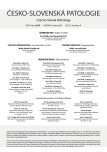-
Medical journals
- Contact
Experimental stab wound
Authors: Miroslav Hirt 1; František Vorel 2; Michal Zelený 1
Authors‘ workplace: Ústav soudního lékařství, Lékařské fakulty Masarykovy univerzity a Fakultní nemocnice u sv. Anny v Brně. 1; Zdravotně sociální fakulta, Jihočeská univerzita v Českých Budějovicích a Soudnělékařské oddělení Nemocnice České Budějovice, a. s. České Budějovice. 2
Published in: Soud Lék., 60, 2015, No. 1, p. 2-3
Category: Original Article
Overview
Stab wounds caused by knives and daggers are usually of different appearances. The knife wound has one edge sharp while the second one is blunt. The wound caused by blow of dagger has both edges sharp. The forensic expert must very often decide whether the knife or dagger was used. The aim of this experimental work was to show how a single-edged knife penetrates the skin and causes the wound typical for the double-edged dagger. The fact was verified. The wound typical for dagger can be found if the knife is used only according to the scheme. The forensic expert can say that a one cutting edge knife was used if the one edge of wound is squared and the other one is sharp. If the both of them are sharp, forensic expert must be very careful in his decision.
Key words:
stab wounds – knife – dagger – forensic expertise.
Sources
1. Procházka I. Poranění ostrým předmětem – rány řezné, sečné, bodné. in: Kolektiv autorů. Soudní lékařství. Praha: Grada Publishing; 1999 : 158.
2. Knight B. Forensic Pathology. Melbourne, Auckland: Edward Arnold London; 1991 : 142.
Labels
Anatomical pathology Forensic medical examiner Toxicology
Article was published inForensic Medicine

2015 Issue 1-
All articles in this issue
- Experimental stab wound
- Alcohol congeners and their implications for medicolegal assessment of drunkeness
- The criteria for appointing experts in forensic medicine
- Confrontation of knowledge on alcohol concentration in blood and in exhaled air
- A case of cerebral hypoplasia/dysplasia detected at autopsy
- Forensic Medicine
- Journal archive
- Current issue
- Online only
- About the journal
Most read in this issue- The criteria for appointing experts in forensic medicine
- A case of cerebral hypoplasia/dysplasia detected at autopsy
- Experimental stab wound
- Alcohol congeners and their implications for medicolegal assessment of drunkeness
Login#ADS_BOTTOM_SCRIPTS#Forgotten passwordEnter the email address that you registered with. We will send you instructions on how to set a new password.
- Contact

